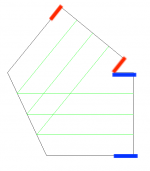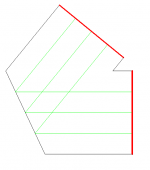I still don't know how to isolate those in a clear way but to me the latest results indicate that the cross-sectional shape (per se) is basically irrelevant in the end. If at all, it will probably be a (very) HF stuff - hard to simulate accurately anyway.I bet non-parallel walls has a positive impact on HOM dampening.
Yes - perhaps one need to go to the next level of physical simulation to nail the HOMs... and to see any other difference re: parallel walls...
//
//
Ok, so you rearrange it but it's still delayed and everything else that goes with diffracted energy.
But we already know how to make horns where diffraction is not an issue. Whether is it round or rectangular at the mouth seems to make very little difference.
By reflecting the wave "away" and make it meet other sized geometries, non parallel walls has a dampening/scattering effect making energy distributed rather than concentrated -> lower Qs in effect. No?
When you say diffraction above, you don't mean from the mouth I suppose?
//
When you say diffraction above, you don't mean from the mouth I suppose?
//
A horn is driven at the throat and the sound wave develops from there. So a rectangular horn is less "coherent" (i.e. with diffraction less concentrated in time and space) than a round one or a 7-sided one (the more sides, the closer it is to a circle, i.e. the more symmetric/coherent it is). That's the situation as I see it.
And because the simulations show that both rectangles and circles can give perfectly smooth results, I really don't see this as an issue. What's crutial is the profile and how it's terminated - that seems to make all the difference.
And because the simulations show that both rectangles and circles can give perfectly smooth results, I really don't see this as an issue. What's crutial is the profile and how it's terminated - that seems to make all the difference.
Last edited:
Yes of course most energy moves orthogonal to the walls we are discussing but HOMs is an energy that "appears" in the other direction - right?
//
//
Lol. As it turns out I just folded a rectangle, once. The far-reaching implications should be obvious 🙂OK but that dont look like it could be a part of any "some"-agon? 🙂
Again, the worst should be a round horn in this regard. And the fact is that is not problematic at all - if done right. How could be worse something that's less symmetric?but HOMs is an energy that "appears" in the other direction - right?
I think an asymmetric would be better yes. But perhaps its not as easy as just how few segments... I do agree that more segments tend to be = round...
So perhaps the lest, uneven numer of sides?
3?
//
So perhaps the lest, uneven numer of sides?
3?
//
Could be 🙂
Four sides are already quite good though, even without a mouth folding back (that wouldn't work so well with a round horn).
That's the nice thing - because of the large asymmetry (compared to a round one), it's not really necessary (although it would surely improve it further).
From the construction point of view, it's no problem either - you can continue to bend the ply back as much as you want. With an octagon, I would definitely add such rolling back. With a rectangle, I would go without.
From the construction point of view, it's no problem either - you can continue to bend the ply back as much as you want. With an octagon, I would definitely add such rolling back. With a rectangle, I would go without.
Last edited:
- Home
- Loudspeakers
- Multi-Way
- Acoustic Horn Design – The Easy Way (Ath4)

